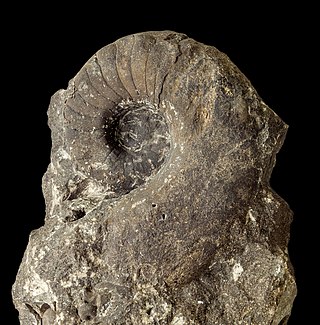The Ellesmerocerida is an order of primitive cephalopods belonging to the subclass Nautiloidea with a widespread distribution that lived during the Late Cambrian and Ordovician.

Trocholites is a tarphycerid genus in the family Trocholitidae from the Middle and Late Ordovician with a gradually expanding, weakly ribbed shell; whorls in contact, dorsum slightly impressed; cross section depressed, venter and sides rounded; siphuncle close to but not at the dorsal margin.
Curtoceras is a genus in the tarphycerid family Trocholitidae of mollusks found widespread in the late Early and Middle Ordovician of North America and northern Europe. Curtoceras has a shell that is gradually expanded, with half the fully mature body chamber divergent from the preceding volution. Whorl sections are near equidimensional with the inner margin (dorsum) moderately impressed. The surface may be smooth or weakly ribbed. The siphuncle is ventral in the initial chamber and becomes dorsal after one volution. With the exception of the dorsal siphuncle, Curtoceras is somewhat similar to the tarphyceratid Campbelloceras
The Tarphyceratidae are tightly coiled, evolute Tarphycerida with ventral siphuncles. The dorsum is characteristically impressed where the whorl presses against the venter of the previous. The Tarphyceratidae are derived from Bassleroceras or possibly from some member of the Estonioceratidae.
Brevicoceras is an extinct nautiloid genus from the order Oncocerida with wide distribution in the Middle Devonian in Eastern North America, Russia and Morocco. Nautiloids form a broad group of shelled cephalopods that were once diverse and numerous but are now represented by only a handful of species in two genera.
Baltoceratidae is an extinct family of orthoconic cephalopods belonging to the subclass Nautiloidea endemic to what would be Asia, Australia, Europe, North America, and South America during the Ordovician living from about 480–460 mya, existing for approximately 20 million years.
Solenochilus, type genus of the Solenochilidae is an extinct cosmopotilian nautilid from the Lower Pennsylvanian to the Lower Permian with a rapidly expanding, coiled globular shell with few whorls, from which prominent spines extend laterally from the umbilical area at maturity. Solenochilus is derived from the Upper Mississippian Acanthonautilus, principally through evolutionary changes in the siphuncle.

Orthoceratoidea is a major subclass of nautiloid cephalopods. Members of this subclass usually have orthoconic (straight) to slightly cyrtoconic (curved) shells, and central to subcentral siphuncles which may bear internal deposits. Orthoceratoids are also characterized by dorsomyarian muscle scars, extensive cameral deposits, and calciosiphonate connecting rings with a porous and calcitic inner layer.
Jovellaniidae was established as a family within the Oncocerida to include genera characterized by longiconic orthocones and cyrtocones with a subtriangular to depressed cross-section in which the ventral (siphuncular) side is typically angular or more acutely rounded than the dorsal (antisiphuncular) side, and in which the siphuncle is generally large, ventral, and with lamellar actinosiphonate deposits

Oncoceratidae is a family of nauatiloid cephalopods in the order Oncocerida established by Hyatt, 1884, that range from the Middle Ordovician to the Upper Silurian.
The Bassleroceratidae is a family of gradually expanding, smooth ellesmerocerids with a slight to moderate exogastric curvature, subcircular to strongly compressed cross section, and ventral orthochaonitc siphuncle. The ventral side is typically more sharply rounded than the dorsal side and septa are close spaced. Connecting rings are thick and slightly expanded into the siphuncle, making the segments slightly concave; characteristic of the Ellesmerocerida.

The Phragmoceratidae is a family of extinct nautiloid cephalopods from the Order Discosorida that lived during the latter part of the Silurian.
Syringonautilidae is a family of Nautiloidea from the middle to late Triassic. Syringonautilidae comprise the last of the Trigonoceratoidea and are the source for the Nautilaceae which continued the Nautiloidea through the Mesozoic and into the Cenozoic right down to the recent. Syringonautilidae is a strictly Triassic family, derived early in the Triassic from the Grypoceratidae.
The Centroceratidae is the ancestral family of the Trigonoceratoidea and of the equivalent Centroceratina; extinct shelled cephalopods belonging to the order Nautilida
Mandaloceratidae is a family in the nautiloid cephalopod order Discosorida, from the Middle and Upper(?) Silurian characterized by short, essentially straight shells referred to as breviconic, typically with a faintly exogastric shape produced by the profile of the body chamber.

Metacoceras is a nautilitoid cephalopod from the Upper Carboniferous (Pennsylvanian) and Permian, the shell of which is moderately evolute with a subquadrate whorl section, bearing nodes on the ventral or umbilical shoulders or both, but otherwise smooth. The siphuncle is small, subcentral and orthochoanitic. The suture has shallow ventral and lateral lobes but no dorsal or annular lobe.

Ellesmeroceras is the type genus for the Ellesmeroceratidae, a family of primitive nautiloid cephalopods, that is characterized by its small, generally compressed, gradually expanded, orthoconic shell, found in Lower Ordovician marine sediments. The septa are close spaced and the siphuncle is ventral, about 0.2 the diameter of the shell. Septal necks are typically orthochoanitic but may slant inwardly (loxochoanitic) or reach halfway to the previous septum (hemichoanitic). Connecting rings are thick. As common for the Ellesmerocerida, Ellesmeroceras has diaphragms within the siphuncle tube.
Plectoceras is a genus of nautiloids included in the tarphycerid suborder Barrandeocerina that lived during the Middle and Late Ordovician. It has been found widespread in the Middle and Upper Ordovician of North America.
Discosoridae comprise a family of endogastric discosorids, with endocones in the siphuncle, ranging from the Middle Silurian to Middle Devonian.
Kentlandoceras is a genus of middle Ordovician Oncocerids. Its shell is curved exogastrically, such that the ventral margin is longitudinally convex, but less so than in Loganoceras, and with a submarginal ventral siphuncle instead. The siphuncle in Loganoceras is subcentral. The related Romingoceras is more curved, also with a ventral siphuncle.





